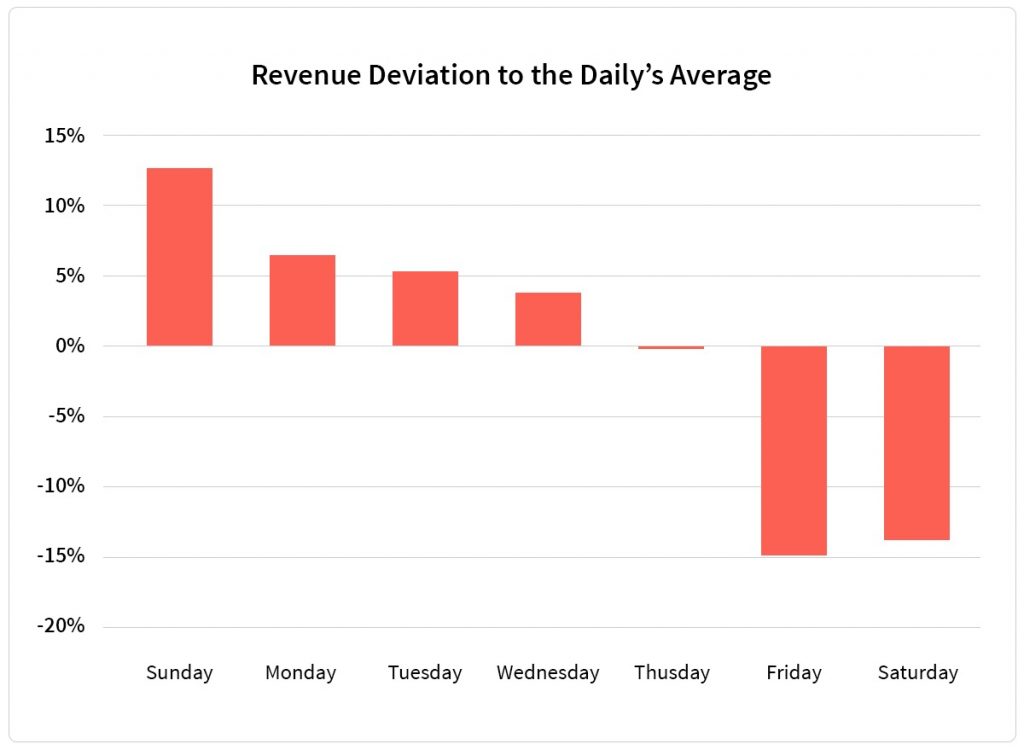What is dayparting?
Dayparting is a popular strategy in PPC advertising, where ads are adjusted at certain times. The theory behind this is that the efficiency of ads is higher on certain days, at certain times of the day, or even in different seasons. Dayparting means that bids and budgets are increased or decreased at different times, depending on how actively customers are shopping online at those times.
This avoids high advertising costs that don’t lead to conversion while allocating enough budget for the times when a conversion is most likely. Campaigns can also be paused completely and reactivated, which is more radical than simply adjusting bids and budgets. Which variant makes sense depends on the purpose for which you want to use dayparting.
Why does it make sense to schedule ads?
The company Workarea conducted a study that examined online retail shopping behavior over the week. Its purpose was to find out when e-commerce sales volume and visitor numbers are the most promising. The study results show that Sundays and Mondays have the most visits, while Friday is the worst day for online retail.
Subscribe to our newsletter
We can observe the same effect on Amazon. On average, Amazon sellers’ sales are the highest on Sundays and Mondays, while they are the lowest on Fridays. On Mondays, the average turnover on Amazon is 6% higher than the general average daily turnover. It’s even 13% above average on Sundays, while Fridays are the lowest with 15% below average.

Dayparting can help optimally use the traffic-rich times for advertising and avoid too many unnecessary advertising costs at traffic-poor times.
In addition, competition on online marketplaces like Amazon is getting tougher as more and more people want to sell their products online. As a merchant on Amazon, you must ensure that your products reach enough people who have a genuine interest in buying them to make your business worthwhile. To stay ahead of the competition, you need to make your ads and ad spending as efficient and profitable as possible. Dayparting can be the key to this!
Advantages of dayparting
There are many benefits of using Dayparting that can have a significant impact on your success on Amazon.
- You can systematically avoid the so-called browsing traffic. Many people browse through Amazon and look at products during this time but do not buy them. Your product will probably receive many clicks at these times but will not be purchased much, which generates unnecessary advertising costs.
- With the help of dayparting, you can reach the people who want to buy your products and not only browse through them. Dayparting can, therefore, significantly increase the probability that a click will also lead to a sale.
- The click-through rate, the conversion rate, and the ACoS of your campaigns will also improve through dayparting. This way, you can improve your overall performance.
- If you have a small budget, then dayparting can help you to use it optimally. You won’t waste your budget on clicks that don’t lead to a conversion, and you’ll have more money available for the periods when your advertising is worthwhile.
What are the limitations of scheduling ads?
Dayparting has many advantages but also a few disadvantages. Some may argue that dayparting is not recommendable because, in PPC advertising, you only pay per click anyway, and every click is in principle good and shows interest. If you generate impressions when there is little traffic, that doesn’t hurt either.
However, this argumentation is not 100% conclusive. Every click has an intention, and this intention is always different. For example, if someone is searching for a “shoe,” the purchase probability is significantly lower than if the person is explicitly searching for a specific shoe from a particular brand. So, in this case, not all clicks are the same. Advertisers should invest different sums in a click, as each click has a different value. Even with exactly the same search queries and ads, the intention can be completely different on different days of the week or at different times of the day. Workarea’s study also underlines this.
Of course, there are scenarios where a schedule doesn’t necessarily apply. For example, if you are launching a new product, the goal in most cases is to first generate as many impressions as possible and reach as many people as possible. Dayparting could have a negative impact here.
In which cases is it beneficial to schedule ads?
Shopping activity
If you identify a specific time when your product gets a lot of sales, it makes sense to push advertising during that time so that even more people see your product. You can scale down the advertising when your product is not bought much to avoid generating unnecessary advertising costs.
Seasonal
This point is quite obvious. For example, if you sell winter jackets, the demand for this product will be pretty low in spring and summer. In autumn and winter, on the other hand, demand is high, and competition is fierce. Here it can make sense to activate the campaigns seasonally or push them firmly when the demand is high.
Events
Amazon shopping events such as Prime Day, Black Friday, or Cyber Monday are extremely important for sellers on Amazon. The demand on these days is extremely high – just as the competition. On Black Friday, for example, the spending of all advertisers increases by about three times. So your bids need to be adjusted accordingly for your products to be displayed at all. With the help of scheduling, you can plan these adjustments early and prepare ahead of time.
Based on the target group
If you know exactly when your target group is most active, it naturally makes sense to exploit these times in particular and ensure higher playout through higher bids.
Example: You use a B2B business model, and your products are sold exclusively to other companies. Your target group is therefore mainly active from Monday to Friday, from 8 am – 6 pm. The playout of your campaigns makes sense, especially at these times, and leads to sales, so you should increase bids and budgets here.
Conclusion
Amazon is becoming more and more complex and offers even more ways to advertise on the platform. To stay ahead of the competition, you need to use your advertising budget as efficiently as possible and reach those people who genuinely want to buy. One way to do this is dayparting. It allows you to run ads when many people with a high probability of buying are active on Amazon. It can improve conversion rate and ACoS, which ultimately positively impacts ads’ overall performance and efficiency.
However, scheduling campaigns manually is time-consuming and important events are often not dealt with in time. For this reason, BidX offers the scheduling function. It allows you to schedule your campaigns in advance based on days, time, or even seasonally. You can either pause the campaigns (out of season) and reactivate them (during the season) or set a boost for special campaigns.
About the author
Nadine Schöpper is the Co-founder of BidX, the tool to master Amazon Ads. Besides her studies in business informatics, she and her partner sold on Amazon themselves. Since the manual management of the ads caused major effort and there was no suitable solution on the market, she founded BidX with Max Hofmann in 2017. The goal is to fully automate Amazon Ads and help clients grow and scale their PPC and DSP Ads. Today, over 1,500 international merchants and agencies rely on BidX’s software solution.



